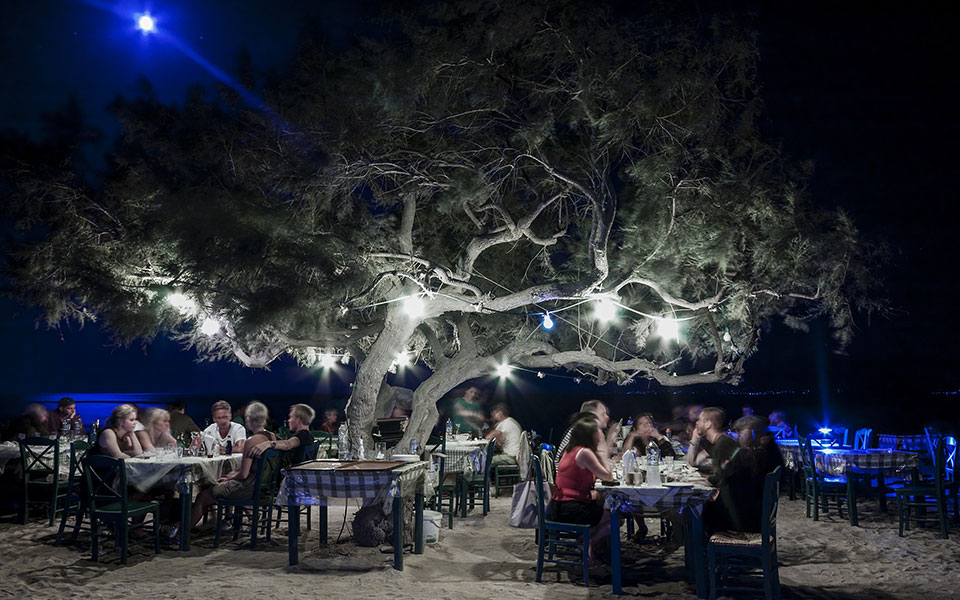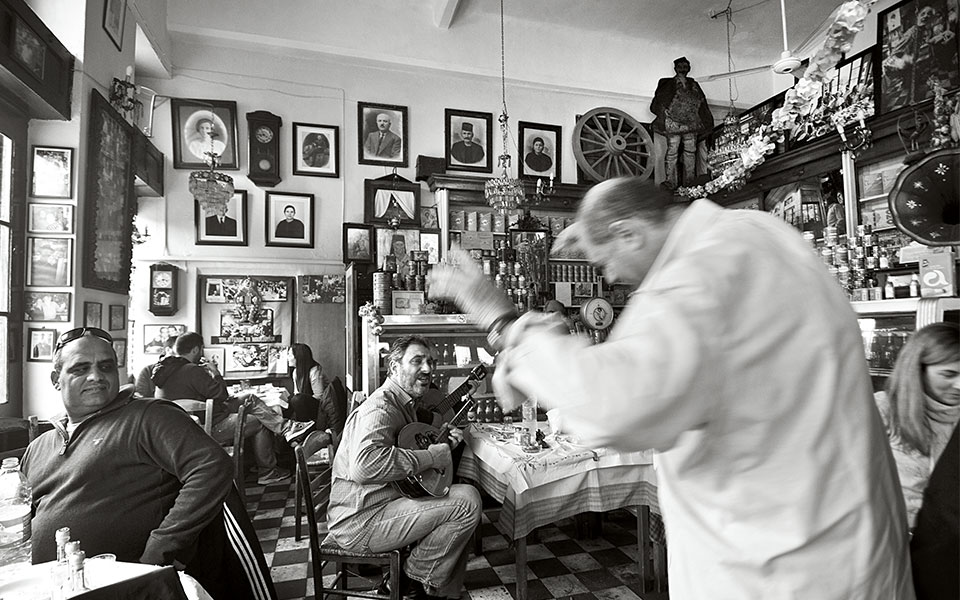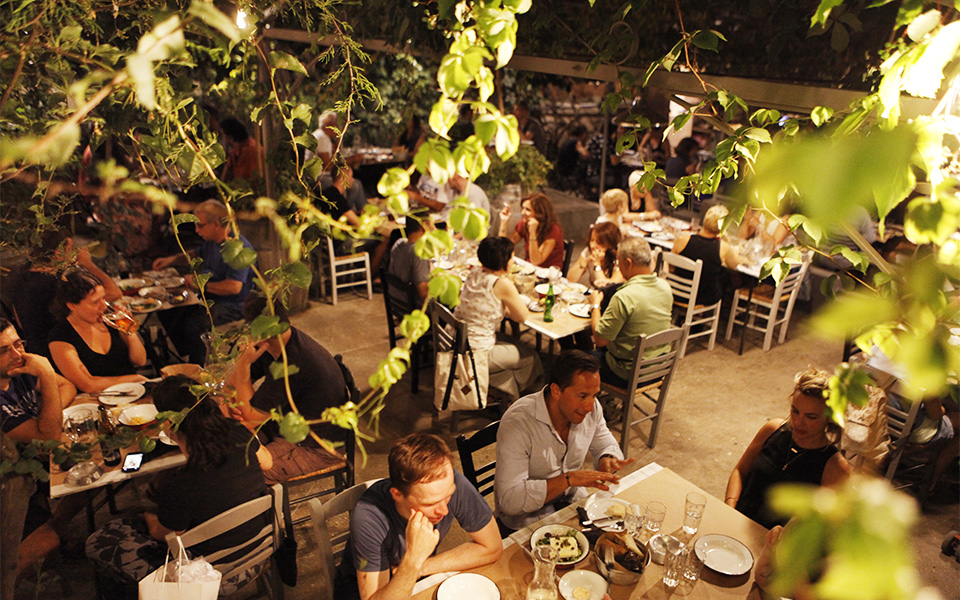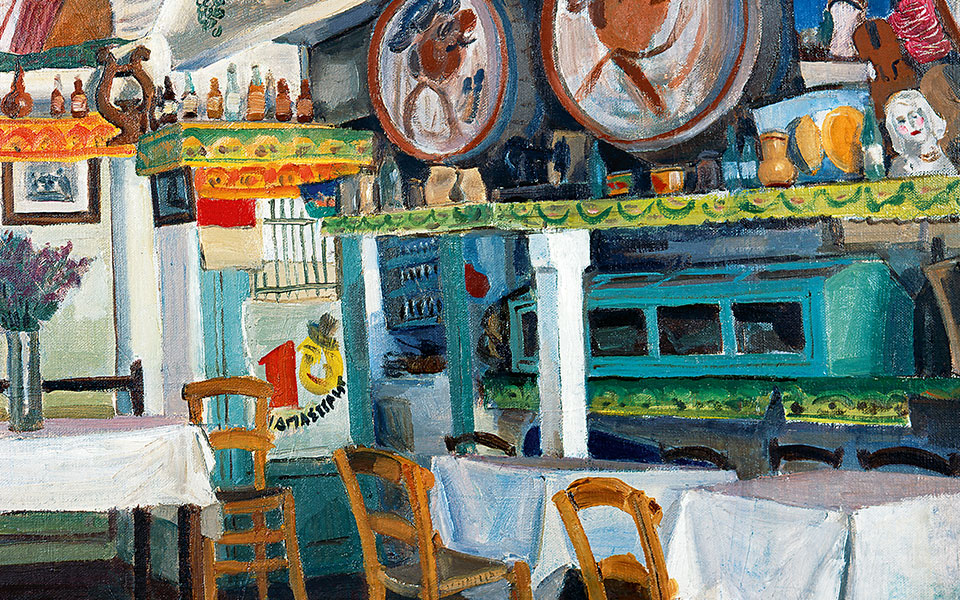Αristeides Papaconstantinou opened “To Eidikon” (The Specialist) in Aghia Sofia, part of the run-down Drapetsona neighborhood of Piraeus, in the early 1920s. He sold basic groceries and had a handful of tables where neighbors could relax and enjoy a simple meal: cheeses produced at the dairy he owned along with his brothers in Gardiki in distant Trikala, a few tomatoes, some olives, tinned sardines and whatever his wife rustled up in her skillet, accompanied by a house wine. It was simple fare: whitebait, batter-fried salted cod, eggs, fried potatoes, corned beef omelets, sausages, liver.
The building itself, which stood on the corner of the street, was a jewel among a haphazard medley of makeshift sheds and huts. This was at a time when a great wave of refugees was arriving on Greece’s shores from Asia Minor, with thousands moving into the neighborhoods of Piraeus and Drapetsona. It is estimated that some 250,000 refugees settled in the greater area of the capital in that period.
A few years later, in another Piraeus quarter – Kaminia – Costas and Grigoris Lambrou watched as the walls of their wine shop and grocery collapsed around them during an aerial bombardment in WWII. Both brothers sustained serious injuries but survived to rebuild their small business, which they dedicated to the Holy Virgin of the Life-Giving Spring (Panaghia Zoodochou Pigis) – just in case – in whose honor the neighborhood church was built.
They sold wine made with must from the plain of Attica, along with pulses, cheeses and various salamis. Occasionally, Costas’ wife Maria would bring a pot of bean stew or some other casserole from home so that their patrons wouldn’t have to drink on an empty stomach. Their retsina wine and Maria’s delicious dishes soon made their store a popular watering hole, attracting a local clientele of colliers, knife-grinders and other manual workers, as well as wrestlers, rebetika singers and sundry toughs. In time, it took the official name of Oinomageirio Zoodochou Pigis.
The two establishments had much in common: they were humble, blue-collar eateries that served simple fare and doubled as grocery and wine stores. In many ways, they were similar to the tavernas of ancient Athens, shops that peddled and served various goods such as wine and foodstuffs. What’s more, they were both located in working-class neighborhoods in the industrial zone of Piraeus and their customers were workers from the port or the factories and machine shops in the area.
As time passed, these small businesses evolved, as did other similar eateries, first into what Greeks call oinomageiria – the Kaminia establishment still bears this word in its name – where the food is all about making the drinking of the house wine easier, and then into the “regular” tavernas they are today: with set menus and the air of a bygone era that is part of their allure. No longer retail stores, they attract their customers with the quality of their cooking.

© Shutterstock
WORKING-CLASS LIFELINES
To Eidikon and the Oinomageirio Zoodochou Pigis, both still run by the families that founded them, are typical examples of the classic Athenian taverna, no different from the hundreds of such businesses that opened in the capital – and later in other cities – in the years following the recognition of the modern Greek state in 1830.
A place to come together, to cultivate the spirit of belonging and shape the community conscience, the taverna is to working-class city folk what the public square and kafeneio (traditional café) are to the country’s villages. The domestic migrants who flocked to the capital in the mid- and late 19th century were desperate for such human contact, and makeshift tavernas popped up in basements or ramshackle huts, always in densely populated blue-collar districts, near the factories and workshops where the city’s new residents earned their living.
These tavernas were where they would spend their lunch break, meet up for a bit of fun in the evening, vent their frustrations and catch up on the gossip about the neighborhood and their hometown. Wine was the protagonist – patrons could also buy some to take home – while the food itself, always simple and moderate in quantity, was a supporting actor. Nearby, there would be grocery stores, greengrocers, fishmongers and butchers that supplied the tavernas with ingredients, which would then be prepared in the same area where they were served. Only later were the tables moved out of the kitchen as these establishments became more commercial, with better food and a more pleasing ambience.

© Clairy Moustaellou
In the early to mid-1900s, newcomers from the villages would head straight to Athens’ tavernas and coffee shops to find accommodation, potential jobs and other opportunities. They could also pick up a few goodies brought in by farmers from rural parts. Come election time, tavernas served as campaign headquarters, platforms of heated political debate and stages for candidates to muster support.
Spaces of participatory and direct democracy, on both a theoretical and practical level, tavernas still serve as a testing ground for theories and ideologies. Patrons will make or break a government (at least they like to think so), pass judgment on the country’s politicians, argue and agree. It is here that public opinion first took shape, and here that the public sphere of the working class is still formed. Back in the day, you wouldn’t find aristocrats, power brokers or bigwigs here. Tavernas belonged to the people – which is why the well-heeled middle class held them in such low regard.
The taverna’s social role was confirmed and strengthened following the Asia Minor catastrophe. The need of the uprooted refugees for contact and communication was great indeed, and they could not entertain friends or relatives in their tiny new homes. Tavernas became the venues for all their social occasions, happy or sad.

© Katerina Kampiti
THE TAVERNA TODAY
In the decades that followed, the taverna underwent another transformation, in which the cooking started to play an increasingly important role. Music, too, which had always been part of the taverna experience, began to change, shifting from folk or demotic to rebetika and other urban genres. But the direct, unpretentious interaction tavernas offer is still the reason why we Greeks choose the taverna, often over the many other entertainment options now available.
Its classless character is beguiling. There are no customs, formalities or hierarchies that need to be observed; everyone eats with everyone, irrespective of generation, social class or bank balance. We are all equal citizens in the taverna. The chairs are packed closely together and the paper table covers are disposable. We still celebrate life here, ritualistically and passionately. News, theories, ideologies, inconsequential and important bits of information, idle talk – they all have a place in the taverna.
But in the end, people are here to eat. The food must be good. Above all, though, it needs to be ample and – most importantly – affordable. Democratic.












